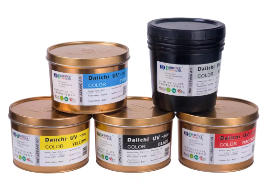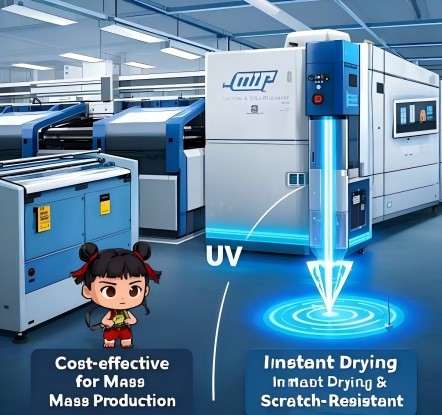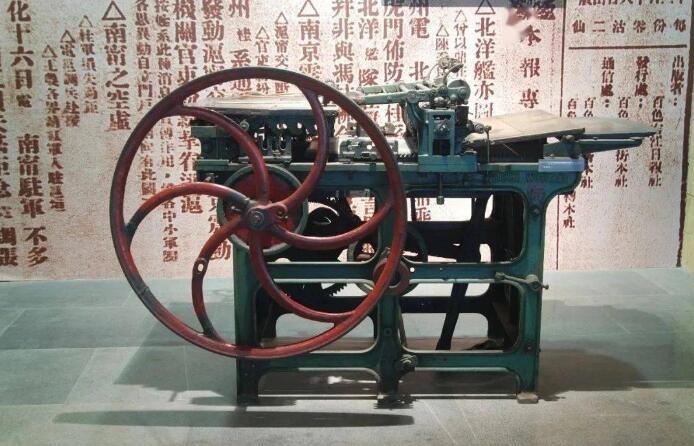 Energy-Curable Ink Market Continues to Grow
Energy-Curable Ink Market Continues to Grow
Apr 25, 2023
Led by growth in UV LED, interest in energy-curable inks is on the rise, driven by energy cost savings and sustainability benefits.
David Savastano, Editor03.08.23
Energy curing has been one of the steadiest growth markets in the ink industry. There are plenty of reasons why the market has been successful; years ago, people cited the instant cure, which allows for faster processing, but the sustainability benefits and energy cost savings of UV and EB inks are of great interest today.
Ultraviolet (UV) and UV LED remain the largest portion of the market, with electron beam (EB) a smaller share. Anecdotally, UV LED is the fastest growing sub-section of the market. Overall, energy curable inks are a sizable business, with consultants placing overall sales at between $2 billion and $3 billion annually.
In terms of companies, UV/EB inks are produced by a wide range of manufacturers. All of the major international ink industry leaders are in the UV ink segment, and there are a few companies – T&K Toka and Zeller+Gmelin – that are primarily focused on energy curable inks and coatings.
In speaking with industry leaders, the UV ink business was solid again in 2022, with more good news on the way. Niklas Olsson, global director product & commercial excellence, Narrow Web at Flint Group, noted that market intelligence suggests the market for energy curing technology is stable with some minor growth, while Hideyuki Hinataya, GM of the Overseas Ink Sales Division at T&K Toka, reported that power-saving UV printing is growing continuously in 2022, partly due to a switch from
conventional printing.
Ed Dedman, flexo technical support/product manager for Zeller+Gmelin Corp., said that overall, the energy curing inks market remained strong in 2022.
“Sales were somewhat impacted by raw material availability, but we were able to push through and maintain a strong sales and supply position,” Dedman reported.
Alexander Blasek, global project manager UV flexo at hubergroup, noted that in 2022, the global UV flexo market remained stable with a slight positive trend.
“Also at the beginning of 2023, we see that this positive trend continues,” added Blasek. “We expect the market for UV flexo applications to further grow within the next few years.”
“UV sheetfed offset printing also continued to grow in the packaging market while the market for UV commercial printing is already saturated in Europe,” noted Roland Schröder, product manager UV Europe at hubergroup.
“It was a challenging year for the printing industry, and the ink industry in general,” said Jonathan Graunke, VP - UV/EB technology and assistant R&D director for INX International Ink Co. “Energy curable technologies were not immune to the supply chain challenges, which made for difficult decisions in the procurement of materials and came at considerable cost. Printers were faced with substrate shortages, and of course labor challenges impacted all. I am really proud of how the INX team embraced the challenges and were able to keep open the supply chain for energy curable ink. This led to a steady year in 2022, and I believe it has opened new opportunities for growth moving forward. I am also personally deeply appreciative of how some of our suppliers were able to support us and the industry.”
Jim Bishop, product manager UV, EB & conventional offset products at Sun Chemical, said that this past year saw the market for energy curable inks and coatings continue to grow.
“Depending on the end use segment, we feel this growth is ranging between 2% and 3%,” Bishop continued. “Many new large format, high-speed UV sheetfed presses were installed in the North America market, and this trend is expected to continue as these new presses bring strong productivity gains. The use of LED for flexo, narrow web, and commercial applications remains very strong too.”
Fabian Köhn, global head of narrow web product management at Siegwerk, reported that the two principal and predominant topics for energy curing inks in 2022 were the high costs and the availability of raw materials.
“This put a big burden and pressure on both ink suppliers and printers,” Köhn said. “Generally, the industry managed this challenge quite well showing an overall stable business in most regions throughout the year. Only China had a particular hard time with several large lockdowns due to the country’s zero COVID policy in 2022 leading to a decline in business in comparison to 2021.”
The UV LED Market
Without a doubt, the fastest growing portion of the energy curable ink business is UV LED. Aside from concerns over the regulatory future of mercury lights, which power conventional UV curing, UV LED offers significant additional benefits for users.
“The general consensus is LED is growing more rapidly,” Graunke said. “Press manufacturers have embraced LED UV curing, and virtually all new narrow web flexo and sheetfed presses have the option to have LED installed. The efficiencies of LED UV and the absence of ozone from a UV lamp make installations less complex with the elimination of certain air flow ducting.”
Graunke added that retrofitting is also a much simpler process.
“UV lamp manufacturers have developed solutions that allow for the conversion of existing UV systems to LED with existing footprints, making it very cost effective,” Graunke noted. “It also allows the user to capture energy savings and eliminate mercury UV bulbs from their process.”
“More and more customers are either ordering new presses or retrofitting existing water-based and UV presses with LED curing systems, primarily because of energy cost savings,” Dedman said. “LED adoption seems to be steadily gaining traction across the print industry, and we fully expect that growth to increase moving forward.”
Hinataya said that UV LED printing has seen more growth. “The reasons for this are speculated to be the rising cost of electricity and the switch from mercury lamps to LED lamps,” added Hinataya.
Blasek reported that hubergroup sees a global trend towards UV LED applications in flexo printing.
“The main drivers are energy cost savings and sustainability,” Blasek said. “We at hubergroup support this and want to collaborate with customers based on long-term concepts. However, LED technology is in sum still more expensive than the traditional UV technology. Consequently, UV drying with mercury vapor lamps is still most common. Within the next years, we expect a further trend towards the LED technology.”
Schröder pointed out that mercury technology is still leading the way in UV sheetfed offset printing. “There have been major leaps in the UV LED technology in recent years but there are still some technical limitations due to the small number of available photoinitiators and the currently still narrow LED absorption spectrum,” Schröder added.
Derrick Hemmings, product manager, EC flexo, screen and LED NA & ECP Canada for Sun Chemical, reported that the LED segment is estimated to be around 15% of the total energy curable graphic arts market.
“We feel that both LED and UV/EB continue to grow at the same rate,” Hemmings said. “RadTech suggests an LED increase from 12% in 2019 to over 20% in 2022. This increase continues to primarily be in digital, commercial offset, screen, and narrow web. Sustainability surrounding energy savings is a key driver of this increase, however, it also can be attributed to increased productivity and throughput.”
Hemmings added that digital, commercial offset, screen, and NWTL (narrow web, tag and label) customers continue to lead the way in UV LED conversion and equipment sales.
“Of primary interest to Sun Chemical are LED for sensitive packaging applications, the need for more compliant, low migration solutions, and heat sensitive substrates for further lightweighting of packaging,” Hemmings said. “These needs, along with the significant energy savings (upwards of 50%) being rationalized by converters, continues to help drive UV LED conversion in graphic arts. It’s worth keeping an eye on LED for commercial print applications, as it presents an excellent value proposition and is gaining traction in the industry. Conversions of conventional sheetfed presses to LED provide an excellent path to higher productivity.”
Olsson said that Flint Group has seen a significant uptake in UV LED products since Q3 2022.
“Contributing to this increase is the focus by printers, converters, and brand owners on reducing their greenhouse gas emissions,” Olsson said. “Currently, Asia and the United States have a larger share of LED lamps. In Europe, there is a large number of pending installations of UV LED lamps. We estimate that lamp installations in Europe will double over the next 12 months, where high energy costs and potential electricity shortages are driving this change.”
Köhn said that as in previous years, UV LED is growing faster than traditional UV, in particular in Europe, where high energy costs act as a catalyst for the LED technology.
“Also in markets like India, Southeast Asia and Latin America, we see an ongoing strong momentum towards UV LED,” Köhn said. “UV LED systems continue to become more and more cost-competitive and more and more new products are launched on the market that complete the offering.”
Read More


 Printing Magic Behind "Nezha 2" Popularity: How Offset & UV Inks Power Movie Merchandise
Printing Magic Behind "Nezha 2" Popularity: How Offset & UV Inks Power Movie Merchandise
 Ink history
Ink history
 Energy-Curable Ink Market Continues to Grow
Energy-Curable Ink Market Continues to Grow